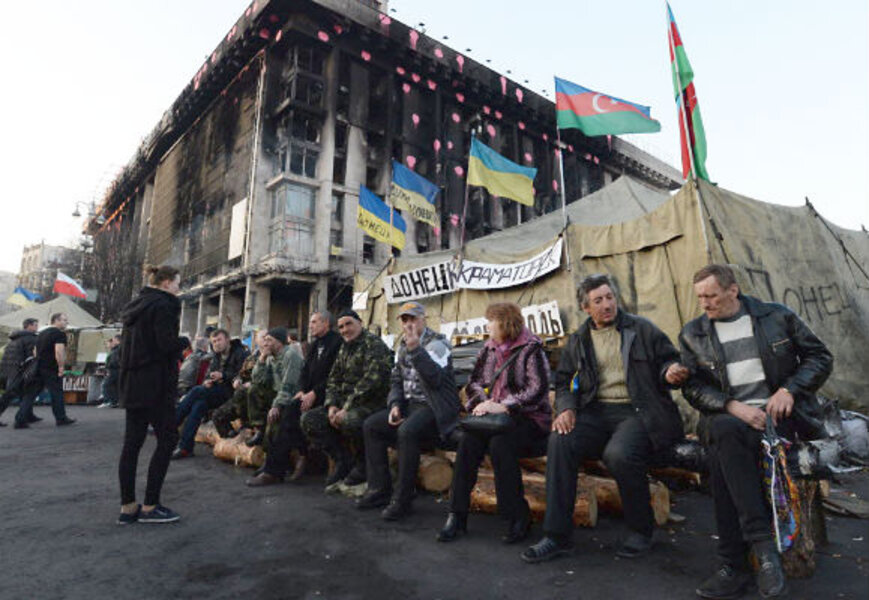On Kiev's Maidan battleground, mission not accomplished
| Kiev, Ukraine
Four months ago, Nikolai Shupkov, a Kiev construction worker, was one of the tens of thousands who gathered on the city’s Independence Square to protest against the government of Ukraine's then-President Viktor Yanukovych. Today, Mr. Yanukovych has been deposed, many protest leaders are part of the new government, and Russian troops are in Crimea and massing along the eastern border.
But Mr. Shupkov, along with hundreds of others, is still on the square demonstrating.
The world's attention may be focused on the tensions between the Kremlin and the West over Russian intervention in Crimea. But for many on the square, known as the Maidan, the internal political crisis in Ukraine is far from over. Protestors like Shupkov are still manning the Maidan’s barricades, performing a new self-assigned role: a kind of a check and balance on the interim government to ensure that their demands for a fair and just Ukraine are met.
“They need to remember that we are here, so that they don’t get too comfortable in their new positions and revert back to the old ways,” says Shupkov, standing near his self-defense unit’s tent. “If they know we are still here, then they’ll know that at any minute, we can rise up again against them. These guys need to understand that they now work for the people of Ukraine.”
A thorn in new government’s side
The square still bears the scars of violent clashes earlier this year that killed more than a hundred and injured close to 1,000. The charred carcass of the former Trade Unions’ building, once the protest headquarters, looms over flower-laden makeshift memorials. Dozens of tents remain standing, although the number of people living in them is on the fall.
But the Maidan is becoming something new, says Volodymyr Panchenko, the director of the International Center for Policy Studies in Kiev. “The Maidan is not just the place it was before. It is now a concept.”
“In many ways, the Maidan has already moved off the streets and into a more active civil society, which is now trying to figure out its way in participating in the running of the country,” he says.
Some Maidan activists, like Yuri Klutsko, say it’s imperative to maintain the protest momentum to prevent it from fizzling out as it did after the Orange Revolution in 2004. The reason that revolution’s winners failed to stick to campaign promises was that the civil society quickly grew complacent, they say. And this time around, they will maintain the pressure on the new authorities rather than rest on their laurels.
Mr. Klutsko comes to the square almost daily during his lunch break to show support. He says demonstrators must remain there as a “symbol of people’s power.”
The activists’ top priority is “rebooting” the system: expelling self-dealing officials, implementing anti-corruption legislation, and strengthening the rule of law in a flawed court system largely controlled by bribes.
Fueling their determination to stay put, the government’s progress has been halting. So far, only two key pieces of legislation have passed: an access to public information law and a measure to reform to the government’s secretive procurement process.
“The problem is that civil society demands big changes, but they often don’t know what those changes should look like,” says Vira Nanivska, the director of Kiev’s International Center for Policy Studies. “Nor do they know how to go about lobbying for those changes in a professional way.”
Civil society groups still have scant experience in campaigning for legislation, she says. And many government officials, schooled in Soviet-era party politics, have scant experience working with civil society.
Ms. Nanivska adds that too often, protesters end up marching up to parliament to demand reforms without a clear objective. “They have to learn how to lobby in sort of a non-revolutionary way. It still looks like war here.”
Indeed, the continued presence of self-defense teams running drills in camouflage and the ultra-nationalist groups like Right Sector – a Maidan paramilitary turned upstart political party – has put the new government in a difficult spot with the protest movement that paved its way to power. The Right Sector has already been clamoring for the firing of the interior minister, after a controversial leader died this week under murky circumstances in a shoot-out with the police.
Russia on the border
The demonstrators say they will remain on the Maidan until their demands are met, which likely means at least through the May 25 presidential elections.
At the same time, the interim government must deal with the most pressing threat: the Russian troops massing on the country’s eastern border after the Kremlin’s annexation of Crimea.
The government has tried to steer the self-defense groups off the streets and into the country’s National Reserves, now recruiting heavily. Indeed, the rhetoric on the square has changed in recent weeks, from anti-Yanukovych to anti-Kremlin.
But many on the Maidan are not willing to follow the government's lead uncritically. Some self-defense groups say they have ignored the order of Prime Minister Arseniy Yatsenyuk to turn in unregistered guns by March 21.
Now was not the time to lay down arms, says Yuri Turayev, a self-defense group member: "The new government practically gave Crimea to Russia by doing nothing. We won’t let that happen again.”
But this sentiment in turn stokes fears among ethnic Russians in eastern Ukraine, who, fed by the Russian media, see armed paramilitary groups as a sign of anarchy in Kiev, says Volodymyr Panchenko of the International Center for Policy Studies. And that anarchy is the sort of pretext that could make a Russian invasion of eastern Ukraine more likely.
With that threat, he says, the reforms that Ukraine needs to fight corruption and fix its teetering economy are hard to reach, he says. “If Russia would disappear from the scene, we would have more time for activism in the proper way.”





